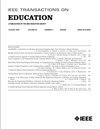量子傅里叶变换在信号分析中的应用论述
IF 2
2区 工程技术
Q2 EDUCATION, SCIENTIFIC DISCIPLINES
引用次数: 0
摘要
贡献:量子计算(QC)在工业、学术和政府应用的数据和信号分析方面具有显著加速的潜力。本文介绍了在线java数字信号处理(J-DSP)本科(UG)展示仿真平台中集成的新型软件工具。背景:为响应国家要求尽早向QC展示UG,我们开发了新的J-DSP功能和量子傅立叶变换(QFT)工具。此外,我们描述了一个实践在线练习的部署和评估,以向UG学生介绍基于qft的信号分析-合成。预期结果:主要目标是通过利用J-DSP中新的交互式QFT工具,使学生接触QC。这些工具可以快速探索关键概念,例如信号分析中的QFT分辨率,量子位精度和噪声效应。学生在我们设计的在线QC练习中使用QFT函数。应用设计:J-DSP交互式在线教育工具是为快速向QC展示UG而设计的。设计并评估了语音分析-合成的QFT练习。UG学生探索在单一的动手博览会会议简单的压缩步骤,包括在音频编码应用程序中使用的QFT峰值拾取。QFT功能是为快速部署和在课堂外展示UG而设计的。结果:对QFT工具的评估是通过前后评估和访谈来进行的,这些访谈检查了对系统的满意度和对知识获取的影响。为了分析这个辅助QC展示工具的影响,我们从两个UG信号处理高级课程和UG (REU)暑期研究经历中招募了学生。配对样本t检验用于检验从评估前到评估后的变化。学生们在之后的评估中表示理解水平有所提高。然而,一些学生报告说,他们有时会在这个系统上遇到困难。然而,大多数与会者表示,该计划适合介绍性/展示性会议。关键洞察:总体而言,学生们认为J-DSP量子工具有效且易于使用,并建议增加更多定性视频材料,并将QC应用于其他数字信号处理(DSP)功能,以进一步提升学习体验。本文章由计算机程序翻译,如有差异,请以英文原文为准。
Education Software Development for Undergraduate Exposition on the Use of Quantum Fourier Transforms in Signal Analysis
Contribution: quantum computing (QC) has potential for significant speedup in data and signal analysis in industrial, academic, and government applications. This article introduces new software tools integrated in the online Java-digital signal processing (J-DSP) simulation platform for undergraduate (UG) exposition to QC.Background: In response to national calls for early UG exposition to QC, we develop new J-DSP functionality and quantum Fourier Transform (QFT) tools. In addition, we describe the deployment and evaluation of a hands-on online exercise to introduce UG students to QFT-based signal analysis-synthesis.Intended Outcomes: The primary goal is to expose students to QC by leveraging the new interactive QFT tools in J-DSP. These tools enable rapid exploration of key concepts, such as QFT resolution, qubit precision, and noise effects in signal analysis. Students use the QFT functions in an online QC exercise that we designed.Application Design: The J-DSP interactive online education tools are designed for quick UG exposition to QC. A QFT exercise on speech analysis-synthesis is designed and evaluated. UG Students explore in single hands-on exposition session simple compression steps, including QFT peak picking used in audio coding applications. The QFT functions are designed for quick deployment and UG exposition outside the classroom.Findings: Evaluations of the QFT tools are conducted with pre and post-assessments and interviews examining satisfaction with the system and impact on knowledge acquisition. To analyze the impact of this supplementary QC exposition tool, students were recruited from two senior UG signal processing classes and from a summer research experience for UG (REU) cohort. A paired samples t-test was used to examine changes from pre to post-assessments. The students indicated increased level of understanding at post-assessments. However, a few students reported having at times difficulty with the system. However, the majority of the participants indicated the program was suitable for introductory/exposition sessions.Key Insight: Generally, students found the J-DSP quantum tools effective and easy to use and suggested that adding more qualitative video materials and applying QC to other digital signal processing (DSP) functions would further enhance the learning experience.
求助全文
通过发布文献求助,成功后即可免费获取论文全文。
去求助
来源期刊

IEEE Transactions on Education
工程技术-工程:电子与电气
CiteScore
5.80
自引率
7.70%
发文量
90
审稿时长
1 months
期刊介绍:
The IEEE Transactions on Education (ToE) publishes significant and original scholarly contributions to education in electrical and electronics engineering, computer engineering, computer science, and other fields within the scope of interest of IEEE. Contributions must address discovery, integration, and/or application of knowledge in education in these fields. Articles must support contributions and assertions with compelling evidence and provide explicit, transparent descriptions of the processes through which the evidence is collected, analyzed, and interpreted. While characteristics of compelling evidence cannot be described to address every conceivable situation, generally assessment of the work being reported must go beyond student self-report and attitudinal data.
 求助内容:
求助内容: 应助结果提醒方式:
应助结果提醒方式:


